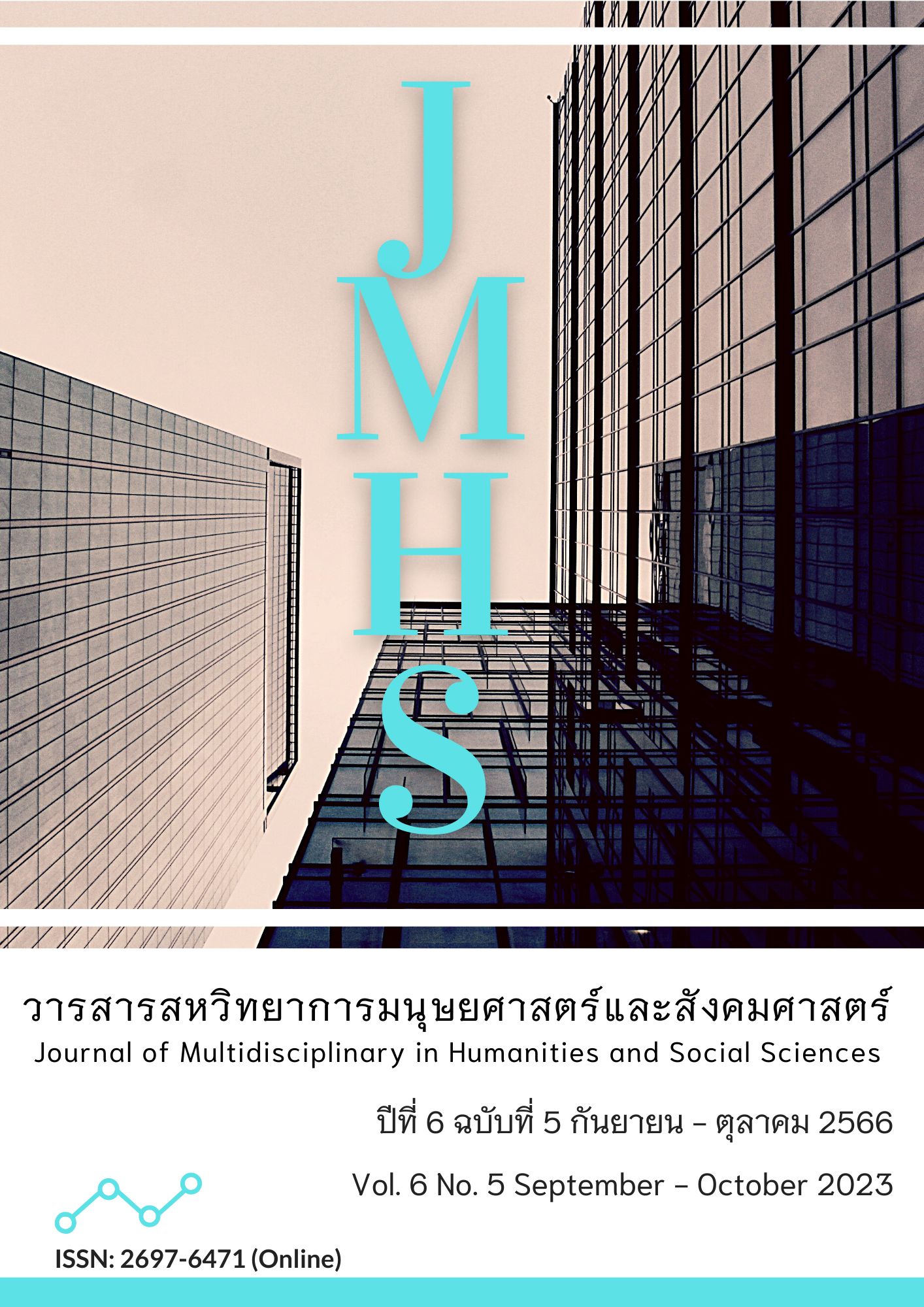Nayamukapdīpanī: Transliteration Translation and Analysis
Main Article Content
Abstract
This article aimed to (1) study NayamukapdĪpanĪ scriptures, including history, structure, content, and grammar related to other scriptures; (2) transliterate the NayamukapdĪpanĪ form of Pali Burmese script into Pali Thai script; and (3) analyze the value of the NayamukapdĪpanĪscriptures content. Continuing the study of the Tripitaka and commentary This research was qualitative, documenting the collaboration of the reviewer, Lane, and reading the book as a research tool framework.
1. The biography of the author named "Buddhacha" is of a monk who specializes in the Pali Tripitaka from Burma. He has more than 59 scriptures. The contents of the Netti Pakorn scriptures have 55 implications, similar to the Upajarnaya scriptures.
2. 107 spells were translated from Pali, Burmese, to Pali, Thai. In terms of translation, the researcher translated from Pali and Thai to Thai. by using the scriptures of Nayamukdi, Pani Padha, and Habits It's a translation guide.
3. The analysis of the structure of the scriptures is divided into 4 parts: worship of the Three Jewels, the Declaration, the 55 implications, and the conclusion. Analyzing the poetry of 8 syllables, Give examples from the Tripitaka, commentary, and grammar scriptures. The language uses concise words. It has a relationship with the Nettipakon scriptures, Tripitaka scriptures, commentaries, statutes, and grammar scriptures. This scripture is valuable. In terms of linguistic implications, it is used as a tool for studying the Buddha's words and disseminating the Dharma. can be used to interpret the meaning of the Buddha's words accurately and completely.
Knowledge from this research I obtained 55 implications of tools for studying the Tipitaka, commentary, and stipulations that were not wrong with the Lord Buddha's wishes. It is a tool to study ancient Pali grammar scriptures according to various implications, such as Niruttinai, etc., to promote the application of knowledge and propagation of the Dharma correctly and appropriately.
Article Details

This work is licensed under a Creative Commons Attribution-NonCommercial-NoDerivatives 4.0 International License.
Views and opinions appearing in the Journal it is the responsibility of the author of the article, and does not constitute the view and responsibility of the editorial team.
References
ชำนาญ เกิดช่อ. (2565). การศึกษาวิเคราะห์คัมภีร์อุตตรวินิจฉยฏีกา. วารสารสหวิทยาการมนุษยศาสตร์และสังคมศาสตร์, 5(3), 1252-1266 สืบค้นจาก https://so04.tci-thaijo.org/ index.php/jmhs1_s/article/view/259878
ธานี สุวรรณประทีป, พระศรีสุทธิเวที (ขวัญ ถิรมโน), พระภาวนาพิศาลเมธี วิ (ประเสริญ มนฺตเสวี). (2565). คัมภีร์อุปาสกชนาลังการ : การปริวรรต การแปล และวิเคราะห์. วารสาร มจร บาฬีศึกษาพุทธโฆสปริทรรศน์, 8(1), 32-42. สืบค้นจาก https://so05.tci-thaijo.org/index.php/ Palisueksabuddhaghosa/article/view/257277
ปรียพร วิศาลบูรณ์, สุรัมภา รอดมณี, เนาวนิจ พึ่งจันทรเดช และ เบญญาภา ทนต์ประเสริฐเวช. (2566). จิตบำบัดตามแนวพุทธจิต: บทวิเคราะห์ในมิติทางการพยาบาล. วารสารสหวิทยาการมนุษยศาสตร์และสังคมศาสตร์, 6(1), 120-140. สืบค้นจาก https://so04.tci-thaijo.org /index.php/jmhs1_s/article/view/261601
พระญาณาลังการเถระ. (2547). ปทวิจาร. กรุงเทพฯ: ไทยรายวันการพิมพ์.
พระธรรมานันทมหาเถระ. (2562). เนตติหารัตถทีปนี อุปจาร และนย. กรุงเทพฯ: ประยูรสาส์นไทยการพิมพ์.
พระมหาสมบูรณ์ วุฑฺฒิกโร. (29 มีนาคม2558). หลักการตีความในเนตติปกรณ์และเปฎโกปเทส. สืบค้นเมื่อ 28 มกราคม 2566, จาก https://www.mcu.ac.th/article/detail/510.
พระวิมลพุทธิเถระ. (2566). นยาสปรกรณ์. กรุงเทพฯ: ประยูรสาส์นไทยการพิมพ์.
พระอรรถชาติ เดชดำรง. (2566). การแบ่งช่วงชั้นทางสังคม : มุมมองของศาสนาพราหมณ์-ฮินดูและพระพุทธศาสนา. วารสารนวัตกรรมการจัดการศึกษาและการวิจัย, 5(2), 481-492. สืบค้นจาก https://so02.tci-thaijo.org/index.php/jemri/article/view/259134
มหาจุฬาลงกรณราชวิทยาลัย.(2500). พระไตรปิฎกภาษาบาลี ฉบับมหาจุฬาเตปิฎกํ. กรุงเทพฯ: โรงพิมพ์มหาจุฬาลงกรณราชวิทยาลัย.
สานิตย์ สีนาค และ ชัยณรงค์ กลิ่นน้อย. (2566). การศึกษาวิเคราะห์คัมภีร์ลิงคปุราณะ. วารสารสหวิทยาการมนุษยศาสตร์และสังคมศาสตร์, 6(1), 106-119. สืบค้นจาก https://so04.tci-thaijo.org/index.php/jmhs1_s/article/view/261500
สุชญา ศิริธัญภร. (2560). วิจารณ์สดุดีคัมภีร์เนตติปกรณ์. วารสารมหาจุฬาวิชาการ, 1(2), 143-155. สืบค้นจาก https://so04.tci-thaijo.org/index.php/JMA/article/view/141209
สุภีร์ ทุมทอง. (2562). เนตติปกรณ์. นนทบุรี: ภาพพิมพ์.
เสฐียรพงษ์ วรรณปก. (2540). พุทธวิธีสอนจากพระไตรปิฎก. กรุงเทพฯ: เพชรรุ่งการพิมพ์.
Damnoen, P. S., Siri, P., Supattho, P. S., & Kaewwilai, K. (2021). The Development of Student Characteristics in According to the Nawaluk Framework of the Buddhist Integration of Buddhapanya Sri Thawarawadee Buddhist College. Asia Pacific Journal of Religions and Cultures, 5(2), 126–135. Retrieved from https://so06.tci-thaijo.org/index.php/ajrc/article/view/249662
Tan, C. C., & Damnoen, P. S. (2020). Buddhist Noble Eightfold Path Approach in the Study of Consumer and Organizational Behaviors. Journal of MCU Peace Studies, 8(1), 1–20. Retrieved from https://so03.tci-thaijo.org/index.php/journal-peace/article/view/235080


